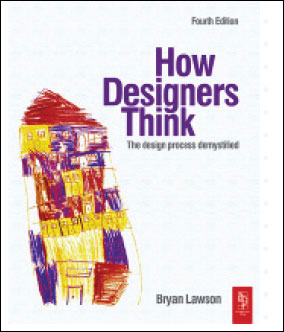This book basically talks about “design” as a process, how that process works, what we understand about it and what we don’t, and how it is learned and performed by professionals and experts.
In this book, the author tries to summarize his various researches and experiment works with design and designers – both professionals and students. He uses various examples for the various topics he covered. Suitable quotes have been given in every chapter to just communicate the essence in a simple way.
This book has been organized into 3 parts:
- What is Design?
- Problems and Solutions.
- Design Thinking.
The whole book is written in a form of discussion and not essentially drawing conclusions about anything. This book provides a deep insight on a complex subject like design. To me it’s like a “design bible”. This book can prove helpful for anyone who is aspiring to become a successful designer. The immense research which has been done by the author about various fields relating to design directly or indirectly is of great value.
With a unique viewpoint, the author follows a very scientific approach towards explaining various aspects of design. He describes design as a “negotiation between problem and solution through the activities of analysis, synthesis and evaluation.” This book also provides an excellent insight on early design principles and methodologies and how theyevolved with time.
In the second part of the book the author talks about various design constraints existing and how the growing gap between designer, client and user affect the end product. He also talks about the importance of finding problems and solving them as well with equal emphasis.
He also describes designers as the creators of future and the responsibility that they have. “The designer has a prescriptive rather than descriptive job. Unlike scientists who describe how the world is, designers suggest how it might be.”
In the third part of the book, he emphasizes on paying attention to the thought processes which are required to identify and understand those design problems and create design solutions. From his discussions, we will come to realize that it is common for designers to carry some set of guiding principles with them through their working lives. This intellectual baggage is most frequently gathered during that career, with each project contributing to it in some way.
To me this book is not be taken as a “onetime read and throw” kind of a book. This book has a potential to be used for reference to understand the most fundamental concepts of design which lacks among so many designers. The section which covers the topic of “thinking about thinking” is very thought provoking. This process is so precious and central to design and he covers it in a very simple way step by step.
This book will take over you as you read it because of the way it is structured. Every topic covered in the book is based on discussions, questions and arguments and illustrations which will compel anyone reading it to think about it over and over again.
The best thing about this book is that each discussion is presented logically, more like a case study rather than an opinion or a speculation which is very often seen in the field of design.
The approach of the author is indeed very honest. The book’s caption “design process demystified” has been truly conveyed in the book .The number of designers and architects interviewed makes this book a true analysis of design.
published by Architectural press
335 pages
This book review was written by: ASN Shashank


Leave a Reply
You must be logged in to post a comment.